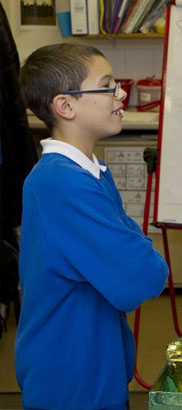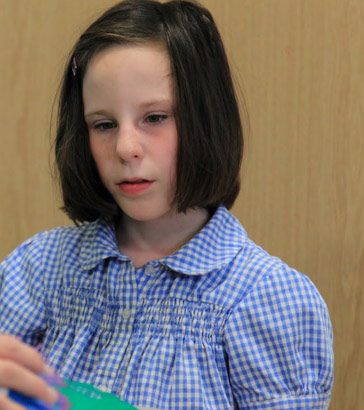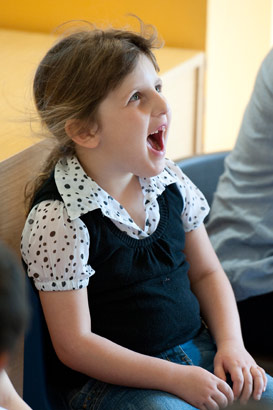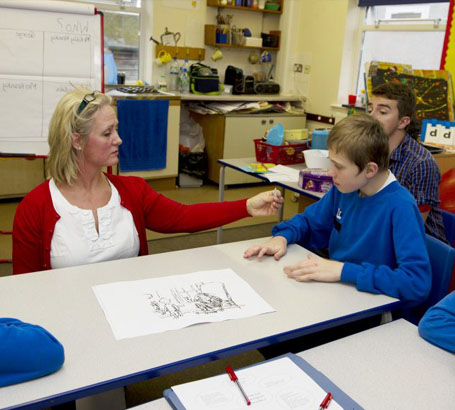
Cognitive Behavioural Therapy (CBT) is often used by mental health professionals
working with adults but it can also be adapted for use with children who have learning difficulties or CLDD.
CBT is a clinically and research proven treatment in mental health.
CBT is increasingly being used, due to the evidence of its effectiveness
with:
- Depression;
- Anxiety;
- Social phobia; and
- OCD, PTSD, social anxiety (eating disorders, substance abuse and many other problems faced in everyday life).
There are over 300 controlled studies exploring the effectiveness of CBT (Butler and Beck, 2000).

Children are disturbed not by events, but by how they interpret events.
Therapists and teachers who use a cognitive behavioural approach are interested in how people attribute meaning to events.

CBT is based on two central tenets:
- That our cognitions have a controlling influence on our emotions and behaviour;
- That how we act or behave strongly affects our thought patterns and emotions.

CBT combines two very effective kinds of therapy – cognitive therapy and behaviour therapy.
- Behaviour therapy: attempts to weaken the connections between troublesome situations and your habitual reactions to them. Reactions such as fear, depression, etc. It can also be used to relax the body and mind, so you can feel better, think more clearly and make better decisions (this is known as Response bias).
- Cognitive therapy assists in showing the person how certain thinking patterns are associated with your symptoms – by giving you a distorted picture of what is going on and making you feel anxious, depressed and/or angry (this is known as Attributional bias).

CBT uses a variety of techniques to change thinking, mood and behaviour. The therapist might for example help a child notice when they are having a negative automatic thought.
Case example: Richard, a man with a social anxiety, was preparing to attend a party in his friend's house. In advance of the party, he had the following negative thoughts:
- 'I won't know what to say';
- 'Everyone will know that I am nervous';
- 'I will look so stupid'; and
- 'I will feel so bad that I will want to leave right away'.
What feelings did these thoughts trigger in Richard?
If the therapist can help Richard notice and change these negative thoughts then Richard will have different feelings.

How is CBT adapted for children with learning difficulties or CLDD?
Practitioners can adapt CBT techniques for children with learning difficulties.
For example, the sessions usually involve work with symbols and pictures and less language. The practitioner carefully paces
the session and uses repetition and practice and prompting.
Usually, there is also an emphasis on helping the child find activities that they find pleasurable and that gives them a real
sense of achievement and improves the mood.
The practitioner will tend to want to involve the child's family, carers, support workers or teachers as co-therapists. This will enable the child to practice techniques outside of the therapy session.

Are there children in your school who you think might benefit from an approach like CBT?
Find out which of the professionals who work with children in your school have been trained to use CBT.
Are there any staff in your school who might be interested in learning more about CBT?

These two CBT based resources are specifically designed for use
with children.
Ironside, V. and Rodgers, F. (2004) The Huge Bag of Worries, Hodder Children's books.
Stallard, P. (2002) Think Good – Feel Good: A Cognitive Behaviour Therapy Workbook for Children and Young People, Wiley-Blackwell.

Butler, A. C. and Beck, J. S. (2000) Cognitive therapy outcomes: A review of meta-analyses, Journal of the Norwegian Psychological Association, 37, 1-4.
Sams, K., Collins, S. and Reynolds, S. (2006) Cognitive therapy abilities in people with learning disabilities, Journal of Applied Research in Intellectual Disabilities, 19(1), 25-33.
Susan, W., White, T.O., Lawrence, S., Oswald, D. and Albano, A.M. (2009) Preliminary Efficacy of a Cognitive-Behavioral Treatment Program for Anxious Youth with Autism Spectrum Disorders, Journal of Autism and Development Disorders, 39,1652–1662.